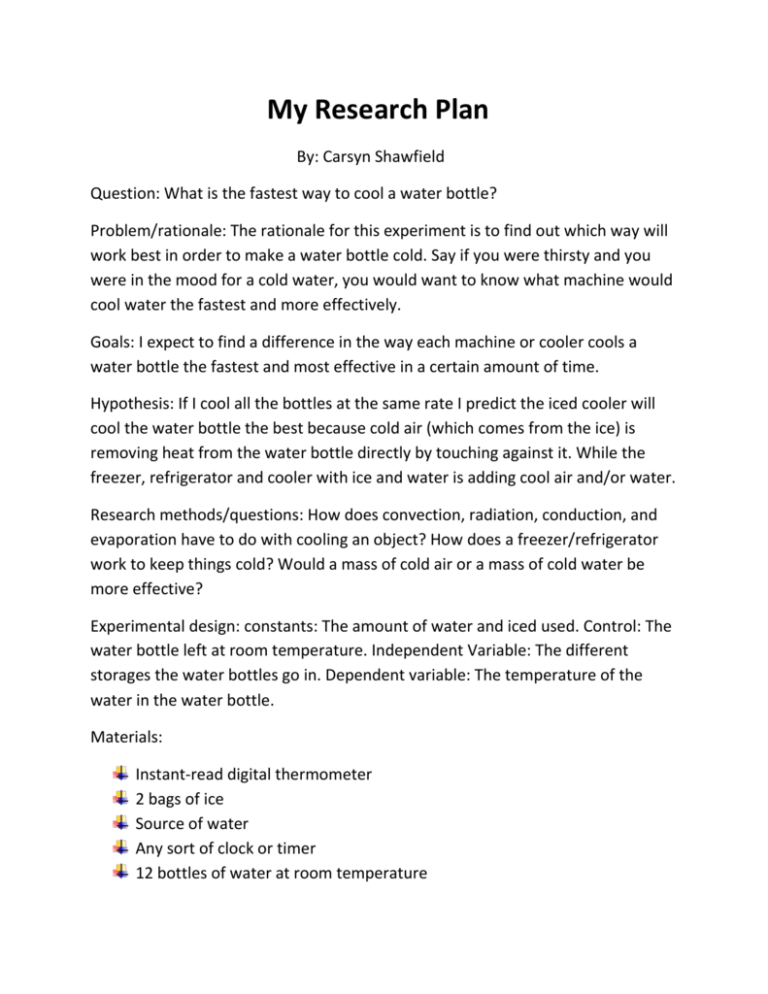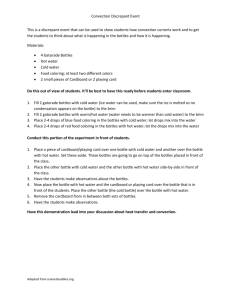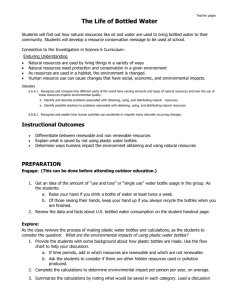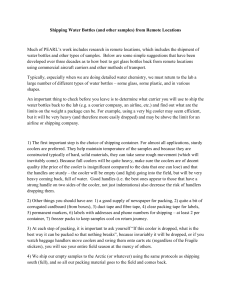File - Start your own free website
advertisement

My Research Plan By: Carsyn Shawfield Question: What is the fastest way to cool a water bottle? Problem/rationale: The rationale for this experiment is to find out which way will work best in order to make a water bottle cold. Say if you were thirsty and you were in the mood for a cold water, you would want to know what machine would cool water the fastest and more effectively. Goals: I expect to find a difference in the way each machine or cooler cools a water bottle the fastest and most effective in a certain amount of time. Hypothesis: If I cool all the bottles at the same rate I predict the iced cooler will cool the water bottle the best because cold air (which comes from the ice) is removing heat from the water bottle directly by touching against it. While the freezer, refrigerator and cooler with ice and water is adding cool air and/or water. Research methods/questions: How does convection, radiation, conduction, and evaporation have to do with cooling an object? How does a freezer/refrigerator work to keep things cold? Would a mass of cold air or a mass of cold water be more effective? Experimental design: constants: The amount of water and iced used. Control: The water bottle left at room temperature. Independent Variable: The different storages the water bottles go in. Dependent variable: The temperature of the water in the water bottle. Materials: Instant-read digital thermometer 2 bags of ice Source of water Any sort of clock or timer 12 bottles of water at room temperature Two Styrofoam coolers A Refrigerator with a freezer compartment Procedure: 1. Prepare an ice-only bath by adding enough ice to a Styrofoam cooler to completely cover three bottles of water 2. Prepare another ice-only bath in the second Styrofoam cooler with the same amount of ice. Then, covering it ice with water until it fills the top of the cooler. 3. Use your thermometer to record the temperatures of the Freezer compartment, the refrigerator, the ice-only bath, and the ice-water bath with no water bottle inside. 4. Also test the temperature of the water inside the bottle. To minimize evaporation, seal the cap on very tight. 5. Place three bottles of water in the Freezer, side by side. 6. Place three bottles of water in the refrigerator in the same position. 7. Place three bottles of water in the ice-only bath so the ice completely covers all three bottles of water. 8. Place three bottles of water in the ice-water bath so all three bottles are completely under water and ice. 9. Note the starting time for each cooling device 10. Every 10 minutes, quickly remove each set of water bottles from their cooling device and measure the temperature before quickly placing them back inside their cooling device. Tip: Try to reduce the amount of time the fridge and freezer doors are open 11. Keep testing 6 times until each cooling device has been equally tested the same amount of time. Record each temperature by removing the cap and using the thermometer for each trial (6 trails). Safety Precautions: none Data Analysis: When measuring the temperature make sure to use Fahrenheit. Each group should have its own section while analyzing; (The Freezer, Refrigerator, ice-only bath and the ice-water bath.) You should observe that each water bottle is colder than it was at room temperature. Bibliography: 1.http://www.sciencebuddies.org/science-fairprojects/project_ideas/Phys_p057.shtml#background 2.http://physicsnet.co.uk/gcse-physics/thermal-energy-transfer/ 3. http://www.newton.dep.anl.gov/askasci/gen06/gen06190.htm 4. http://www.wired.com/2013/11/how-do-things-cool-withevaporation/ 5. http://www.realsimple.com/food-recipes/toolsproducts/appliances/how-does-refrigerator-work









